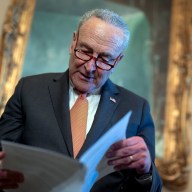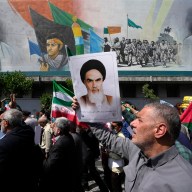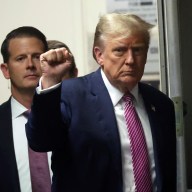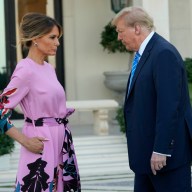 Jon Kane and Godfrey Reggio collaborated on the new maximalist art film “Visitors.”
Jon Kane and Godfrey Reggio collaborated on the new maximalist art film “Visitors.”
Credit: Getty Images
Godfrey Reggio’s 1983 art film “Koyaanisqatsi” is a sensory experience: the maddening Philip Glass score combined with time lapse photography — then radical and fresh, now a fixture of every third commercial — hurls viewers through literally speeding images that capture the hustle of urban life. But it also had a clear message: man has conquered the planet. Whether it was a triumph or a desecration was left up to the viewer.
Reggio’s latest film, “Visitors,” is a bit tougher to pin down. It’s 87 minutes of crisp, digital, black and white images of people staring back at you. Occasionally it shows a calm gorilla or a desiccated building. There are only 74 shots. Knowing Reggio’s other films — including the third world-centered “Powaqqatsi” and “Naqoyqatsi,” concerning mankind’s move into a digital world — one expects a warning, a tut-tutting message.
Reggio insists that’s not the way into “Visitors.” “Poetic cinema is not based on logic,” Reggio says. “Less is more. It doesn’t appeal to your head. It’s not about an idea. What I try to say is if you’re going into this thing looking for meaning, you could miss the whole film. I would recommend you be like a traveler, just sit down and take in the sights.”
“It’s like a deprogramming process,” says Jon Kane, the film’s editor and assistant director. “You’re seeing the familiar: the frame. It’s a motion picture. The environment’s familiar. But what you’re confronted with is totally unfamiliar.” The film has element of abstraction, Kane explains. “But we’re creating images that are for the most part not abstract. In fact our main images are the most familiar thing ever, which is the human face.”
But there is a message, albeit a more general one, and one that ties in with “Koyaanisqatsi.” Where that film had movements, some slow and contemplative, others rapid and mind-melting, “Visitors” is like a single movement. To call it glacial would be to imply it’s going somewhere. That makes it alien in our ever-increasingly fast-paced culture.
“We’re on speed and rush hour in our future, so this film is like ‘Whoa,’” Reggio states. “You’re not used to being this slow. It makes us nervous to have something so slow in front of us.”
“It’s also a twist to have something slow be so confrontational,” Kane adds. “Confrontation involves energy. This does a ju-jitsu on that idea. You end up looking at yourself, in a way.”
The changing face of exhibition is something else “Visitors” tacitly brings up. Movies, like most media, are moving towards the digital and the personal: viewed on TVs and gadgets when one wants, not at fixed times for mass consumption. This is a film that needs to be seen on a big screen. But Reggio and Kane go further.
“The way the film is designed to be seen is on a giant screen with a live orchestra in a big opera house,” Kane states. While the film is getting a traditional art house-style theatrical release, playing major cities, there are also plans to “eventize” it. It’s playing the Hollywood Bowl and the Sidney Opera House, as well as Moscow and Guadalajara.
But even seeing it theatrically during the week, when audience turnout tends to be low or non-existent, works, too. “This is a great film to see by yourself, because it’s very personal,” Reggio says. “I’m recommending people go when only a few people are in the theater. It’s a solitary experience as well as a social experience.
“The scale can envelop the audience, because the room is dark and it’s a social event,” Reggio says. “But it’s a social event in silence. There are very few social events we do in silence. Maybe a funeral.”
Reggio didn’t come to filmmaking in any traditional way. In fact he rarely watched films before he directed “Koyaanisqatsi.” From 14 to 28, he was a monk. The meditative aspects of his former life do more to inform “Visitors” than other people’s films. He even points out the movie that made him get into filmmaking — Luis Bunuel’s “Los Olvidados,” about kids living in Mexico slums — is in style and in content (“Powaqqatsi” excepted) nothing like his own work.
Even today he claims to not watch many films — a stark contrast to documentarian Errol Morris, a habitual moviegoer, or the late Stan Brakhage, who saw everything. “I’m not saying I haven’t seen films, please. But I’m not a devotee,” he admits. He watches the occasional old movie, plus basketball. “I do watch sports, because it’s live and that’s interesting to me.”
Kane does tell Reggio he’s not being entirely open: “You introduced me to ‘Homeland.’”
















